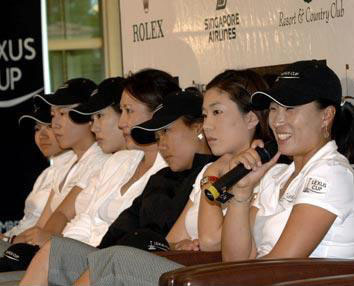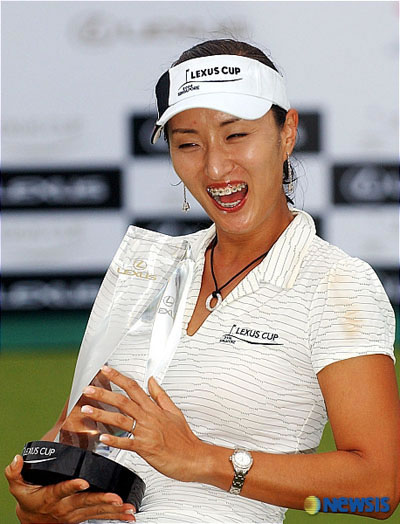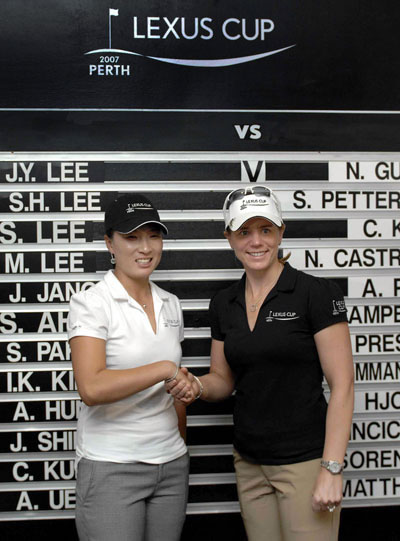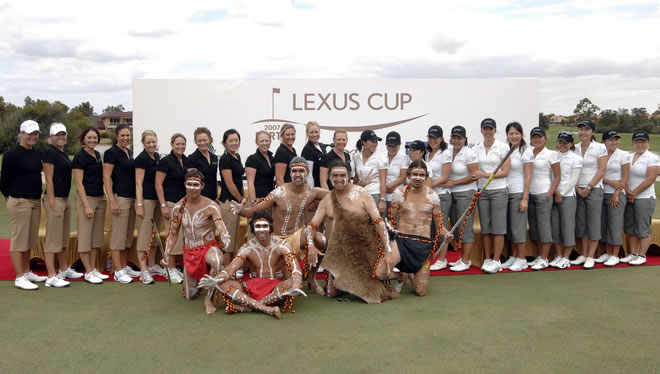 |
 |
 |
 |
 |
 |
2007 Lexus Cup
Exclusives , Results
 Every
other year, the Solheim Cup features a battle between a team of women
golfers from Europe and one from America. Started in 1990, the event took
a few years to get off the ground. For the first few contests, the Americans
were pretty much the dominant squad; but after a while, the Euros began
to even the match. Before long, the LPGA started to promote the event
as the most important in all of women's golf.
Every
other year, the Solheim Cup features a battle between a team of women
golfers from Europe and one from America. Started in 1990, the event took
a few years to get off the ground. For the first few contests, the Americans
were pretty much the dominant squad; but after a while, the Euros began
to even the match. Before long, the LPGA started to promote the event
as the most important in all of women's golf.
The problem, even early on, was that so many strong golfers were omitted from playing in the event, based solely on where they were born. As early as 1998, just 8 years after it had started, two of the top women in the LPGA, Se Ri Pak and Karrie Webb, were excluded from participating. By the middle of this decade, the number of top players in the world who couldn't play the event was getting absurd; just the number of top 30 golfers on the money list who were Korean, and thus ineligible to play, was significant. By the time Lorena Ochoa climbed towards the top spot on the money list (she being yet another golfer excluded from Solheim), it became clear that something had to be done. But the Solheim family, in charge of the format for the Cup, steadfastly refused to change its format to allow the other international players in. And thus was born the Lexus Cup.
The Lexus Cup apes the format of the Solheim Cup; it features two teams
of 12 golfers playing in three match play rounds of golf. The first round
pits six pairs of twosomes against each other in the foursome format (each
team plays one ball, the players taking turns striking it). The second
day again matches six groups of twosomes, but this time using the four
ball format (in which the teams each play the better ball of the two players).
The third day features twelve singles match play matches. A win counts
for a point, while a tie gives each team a half a point. The first team
to exceed 12 points wins the Cup.
 The
event started in 2005. It was decided that the teams would be Asia vs.
everybody else, a decidedly lopsided team structure to say the least.
Not that there aren't a lot of strong Asian golfers, but to pit any one
continent, no matter how strong, against the combined might of the rest
of the world seems a bit unfair. The match took place in Singapore that
year, with Annika Sorenstam, then the world's number one player, captaining
the International squad, while Grace Park was the Asian team captain.
Grace was in the midst of a bad slump (from which she still hasn't recovered),
and her team was pretty thoroughly beaten that year. The International
squad wound up doubling the point total of the Asian team in every single
round. With such a shaky start, there was a big question of just how good
an idea the Lexus Cup format was.
The
event started in 2005. It was decided that the teams would be Asia vs.
everybody else, a decidedly lopsided team structure to say the least.
Not that there aren't a lot of strong Asian golfers, but to pit any one
continent, no matter how strong, against the combined might of the rest
of the world seems a bit unfair. The match took place in Singapore that
year, with Annika Sorenstam, then the world's number one player, captaining
the International squad, while Grace Park was the Asian team captain.
Grace was in the midst of a bad slump (from which she still hasn't recovered),
and her team was pretty thoroughly beaten that year. The International
squad wound up doubling the point total of the Asian team in every single
round. With such a shaky start, there was a big question of just how good
an idea the Lexus Cup format was.
In 2006, the event was again held in Singapore, which is supposedly 'home
court' for the Asian squad, but in reality is about as European a spot
you could find and still be in Asia. Grace and Annika were once again
the captains of their squads, but this time Grace had more say in the
players chosen for her team. She picked a strong lineup of Koreans to
anchor the team, including Se Ri Pak, now recovered from the vicious slump
she was suffering in 2005. The match was much closer this time, with both
teams gaining the same number of points on day one, and the Asian squad
taking a small lead after day two. In the end, Seon Hwa Lee won the crucial
match against fellow rookie Julieta Granada to capture the cup for the
Asians by a slim margin. It was an intense three days of golf, and augured
well for the future of the tournament. The Cup was still not attracting
all the top talent it could (particularly on the International side),
but enough strong golfers showed up for both teams to indicate that the
Cup was gaining in stature.
 This
year, the sponsors decided to play the cup for the first time in a non-Asian
country. It was held in Perth, Australia, at the Vines Resort and Country
Club. It was an interesting idea to have the event in Australia, since
there were almost no important Australian players involved in the event
(Karrie Webb, whom the organizers no doubt were hoping would show up,
took a pass). But being the event takes place in mid-December, you are
limited to where you can stage it to places where the weather will be
somewhat decent that time of year. In any event, Annika Sorenstam, no
longer the world's number one but still a formidable talent, once again
was the captain of the International squad, while newly minted Hall of
Famer Se Ri Pak replaced Grace Park as the captain of the Asian team (Grace,
unfortunately, was not even invited to play this year). As in 2006, the
Asian squad relied heavily on its strong Korean contingent. Besides Pak,
the team included vice-captain Sarah Lee, who was having a comeback year
of sorts in 2007; young LPGA stars Jee Young Lee, Seon Hwa Lee, and In-Kyung
Kim; top ten talent Jeong Jang, who had been on the 2005 team but missed
the 2006 edition; and two golfers who were loaded with talent but had
been slumping of late, Shi Hyun Ahn and Meena Lee. Another Korean on the
team was the top ranked Korean golfer on the Rolex rankings, KLPGA superstar
Ji Yai Shin, who came into the event fresh off a KLPGA year which saw
her win 9 times in 18 starts. So nine of the twelve players on the squad
were Korean, meaning, if the Asian team were to retain the cup, they would
be depending on that bevy of Seoul Sisters to carry the day. The rest
of the team were Taiwanese stars Amy Hung and Candie Kung and JLPGA player
Ayako Uehara. Among those who were notably absent were the top Korean
on the LPGA money list, Mi Hyun Kim, who was suffering many injuries but
who still had played the week before at the Kyoraku Cup, and some other
top Koreans like Young Kim (who had won in 2007), Inbee Park, Eun Hee
Ji and Sun Ju Ahn. Then there was the notable absence of JLPGA stars.
Uehara is a good player, but far from the top Japanese or Korean player
in that league. Momoko Ueda, for instance, had won the Mizuno Classic
to earn LPGA status only a few weeks before, and was the top player on
their tour this year. She, Shinobu Moromizato, Ai Miyazato, Yuri Fudoh,
and Shiho Ohyama were among the top Japanese stars who did not play, and
Koreans like Mi Jeong Jeon, Bo Bae Song and Hyun Ju Shin, all stars in
Japan, also were not invited. There were no golfers from Thailand, the
Philippines or China on the squad, either, and you could make a good case
for including the likes of Aree Song, Jennifer Rosales, or Chinese stars
Na Zhang or Shanshan Feng. Still, the team that Se Ri was leading was
a strong one, chock full of very accomplished ladies.
This
year, the sponsors decided to play the cup for the first time in a non-Asian
country. It was held in Perth, Australia, at the Vines Resort and Country
Club. It was an interesting idea to have the event in Australia, since
there were almost no important Australian players involved in the event
(Karrie Webb, whom the organizers no doubt were hoping would show up,
took a pass). But being the event takes place in mid-December, you are
limited to where you can stage it to places where the weather will be
somewhat decent that time of year. In any event, Annika Sorenstam, no
longer the world's number one but still a formidable talent, once again
was the captain of the International squad, while newly minted Hall of
Famer Se Ri Pak replaced Grace Park as the captain of the Asian team (Grace,
unfortunately, was not even invited to play this year). As in 2006, the
Asian squad relied heavily on its strong Korean contingent. Besides Pak,
the team included vice-captain Sarah Lee, who was having a comeback year
of sorts in 2007; young LPGA stars Jee Young Lee, Seon Hwa Lee, and In-Kyung
Kim; top ten talent Jeong Jang, who had been on the 2005 team but missed
the 2006 edition; and two golfers who were loaded with talent but had
been slumping of late, Shi Hyun Ahn and Meena Lee. Another Korean on the
team was the top ranked Korean golfer on the Rolex rankings, KLPGA superstar
Ji Yai Shin, who came into the event fresh off a KLPGA year which saw
her win 9 times in 18 starts. So nine of the twelve players on the squad
were Korean, meaning, if the Asian team were to retain the cup, they would
be depending on that bevy of Seoul Sisters to carry the day. The rest
of the team were Taiwanese stars Amy Hung and Candie Kung and JLPGA player
Ayako Uehara. Among those who were notably absent were the top Korean
on the LPGA money list, Mi Hyun Kim, who was suffering many injuries but
who still had played the week before at the Kyoraku Cup, and some other
top Koreans like Young Kim (who had won in 2007), Inbee Park, Eun Hee
Ji and Sun Ju Ahn. Then there was the notable absence of JLPGA stars.
Uehara is a good player, but far from the top Japanese or Korean player
in that league. Momoko Ueda, for instance, had won the Mizuno Classic
to earn LPGA status only a few weeks before, and was the top player on
their tour this year. She, Shinobu Moromizato, Ai Miyazato, Yuri Fudoh,
and Shiho Ohyama were among the top Japanese stars who did not play, and
Koreans like Mi Jeong Jeon, Bo Bae Song and Hyun Ju Shin, all stars in
Japan, also were not invited. There were no golfers from Thailand, the
Philippines or China on the squad, either, and you could make a good case
for including the likes of Aree Song, Jennifer Rosales, or Chinese stars
Na Zhang or Shanshan Feng. Still, the team that Se Ri was leading was
a strong one, chock full of very accomplished ladies.

Sorenstam had a good team on her side, too, and it looked worrisomely like they would be able to take the cup back again. Her top guns included the #2 player on the LPGA this year, Suzann Pettersen, as well as top Americans Natalie Gulbis and Morgan Pressel (Paula Creamer was not on the team this year). Also present was US Women's Open winner Cristie Kerr, meaning three of the four Major winners in 2007 were on the International squad. The team also included 2007 winners Stacy Prammanasudh, Nicole Castrale, Brittany Lincicome and Maria Hjorth, as well as Solheim veteran Catriona Matthew. The token Australian was Nikki Campbell, a decent player but by no means in the class of the other women mentioned. Lastly, the International team had the LPGA's rookie of the year, Angela Park. Yes, one of the Seoul Sisters was on the enemy team! Of course, that's because Angela is from Brazil, and so would qualify as an international, despite her Asian heritage. But it marked the first time that a fully ethnically Asian player was on the International team (although Prammanasudh is also part Asian). This was a fairly strong squad, although missing some top talent, including, obviously, world #1 Lorena Ochoa and world #3 Karrie Webb, as well as Paula Creamer. But even without those three, it looked like Asia would be in for a tough competition.
That's why the results, particularly on the first day, were so surprising. The Asian squad played brilliantly, and by the end of the foursome competition, they had done something no other team had done in this event so far: they had won every single match played. Some of the matches were close, some were blowouts, but in the end, the International faced an 0-6 deficit when action concluded Friday evening.